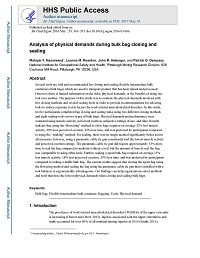Mining Publication: Analysis of Physical Demands During Bulk Bag Closing and Sealing
Original creation date: May 2016
Authors: MF Nasarwanji, LM Reardon, J Heberger, PG Dempsey
Several tools are sold and recommended for closing and sealing flexible intermediate bulk containers (bulk bags) which are used to transport product that has been mined and processed. However, there is limited information on the risks, physical demands, or the benefits of using one tool over another. The purpose of this study was to evaluate the physical demands involved with two closing methods and several sealing tools in order to provide recommendations for selecting tools to reduce exposure to risk factors for work-related musculoskeletal disorders. In this study, twelve participants completed bag closing and sealing tasks using two different closing methods and eight sealing tools on two types of bulk bags. Physical demands and performance were evaluated using muscle activity, perceived exertion, subjective ratings of use, and time. Results indicate that using the "flowering" method to close bags required on average 32% less muscle activity, 30% less perceived exertion, 42% less time, and was preferred by participants compared to using the "snaking" method. For sealing, there was no single method significantly better across all measures; however, using a pneumatic cable tie gun consistently had the lowest muscle activity and perceived exertion ratings. The pneumatic cable tie gun did require approximately 33% more time to seal the bag compared to methods without a tool, but the amount of time to seal the bag was comparable to using other tools. Further, sealing a spout bulk bag required on average 13% less muscle activity, 18% less perceived exertion, 35% less time, and was preferred by participants compared to sealing a duffle bulk bag. The current results suggest that closing the spout bag using the flowering method and sealing the bag using the pneumatic cable tie gun that is installed with a tool balancer is ergonomically advantageous. Our findings can help organizations select methods and tools that pose the lowest physical demands when closing and sealing bulk bags.

- An Approach to Identify Jobs for Ergonomic Analysis
- Bag and Belt Cleaner Reduces Employee Dust Exposure
- A Checklist for Evaluating Cab Design of Construction Equipment
- Development of Ergonomics Audits for Bagging, Haul Truck and Maintenance and Repair Operations in Mining
- Implementation of an Ergonomics Process at a US Surface Coal Mine
- Physical Strength Assessment in Ergonomics
- Reducing Low Back Pain and Disability in Mining
- Strength Testing
- Technology News 554 - ErgoMine Targets Ergonomics and Safety Issues in Mining
- Working in Unusual or Restricted Postures